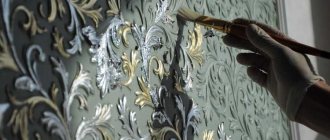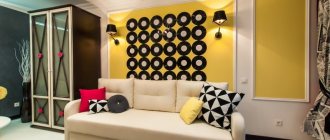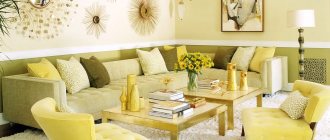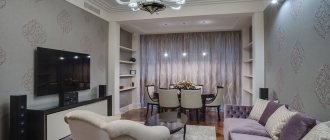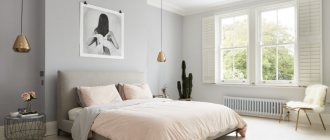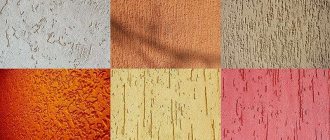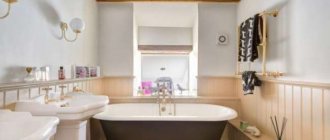Old boards, brick, decorative concrete, gypsum plaster, moss panels - these are just some ideas for decorating walls in the living room. If you already have fairly smooth, painted surfaces, be sure to read our article. We offer options on how to decorate the walls in the living room and how to use selected materials to decorate the interior.
The most important rule: be moderate. If you don't want chaos to creep into your interior, don't combine several completely different materials. You will get a great effect if you select one of the walls and paint the rest in a uniform color. Which wall should I use as an accent wall? Preferably one that is located in a strategic place and involuntarily catches the eye. As a rule, this is the wall in the living room with the TV or the wall behind the sofa. Has the location been found? It's time to choose materials!
Brick on the wall in the living room
Brick is a practical choice because it works with most materials; goes well with wood, stone, glass and steel. In the red version it catches the eye and warms up the interior; in the white version it optically expands the living room and creates a cozy, Scandinavian atmosphere.
If you want to use brick on your living room wall , you have two options - you can show off an old wall or put brick tiles on the wall.
The first solution is for people who live in a historic apartment building, former factory building, or other place with history. Once opened, the brick must be carefully cleaned and soaked, but the effect is definitely worth the effort.
Concrete wall in the living room
The concrete wall in the living room can be made of architectural concrete in the form of ready-made decorative panels. A cheaper, but also effective solution is to use structural paints or plasters, which give the surface a characteristic rough structure and gray color.
Concrete is an elegant and somewhat raw material, so it is worth visually insulating it. To do this, simply introduce a colorful accent into the interior, such as a yellow chair, turquoise pillows, lush green plants (for example, a spreading monstera, fig tree) or natural wood.
Concrete slabs, paints and plasters can brighten up any empty wall, but they will definitely look better than finishing the walls in a TV living room. The large flat screen on the gray rough surface looks ultra-modern and elegant.
No. 2. Painting
Painting walls is another classic option, which has the following advantages:
- ease of execution;
- maintaining the usable area of the room;
- the ability to use any of thousands of shades, combine several colors, creating an accent wall or even entire drawings;
- It is difficult to damage such a coating, so it is used in homes where there are children and animals;
- if there are complex elements in the living room, painting is much easier than, for example, hanging wallpaper;
- low cost.
An accent wall looks very impressive in the interior , with the help of which you can visually make the room larger, bring the highlighted wall closer or remove it. When choosing a paint color for the walls, it is important to consider not only the style of the living room, but also its size, as well as its orientation relative to the cardinal directions.
For a small room it is better to use light colors; for a living room with windows facing south - warm shades; for windows facing north - cold ones. water-based paints are excellent for painting living room walls : they dry quickly, do not smell, and can be tinted. Glue and silicate paints also perform well , but it is better to avoid using oil paints.
Among the disadvantages of such finishing is the need to carefully prepare the original surface, because it must be even and smooth. If you are going to use glossy paint, then you need to approach the alignment of the walls even more carefully.
Wallpaper for the wall in the living room
Wallpaper in the living room can cover the entire wall, from floor to ceiling, or appear in a duet with elegant panels. It is worth taking advantage of its benefits by decorating the wall behind a fashionable sofa, antique chest of drawers or bar counter. Correctly selected wallpaper will direct all attention to the piece of furniture and emphasize its advantages.
The choice of design is an individual matter. Wallpapers featuring large flowers, exotic plant leaves, graphic animals and geometric patterns are on the rise these days. Some of them resemble illustrations from children's books; they are colorful and playful. Others allow you to create a dramatic, theatrical effect in the interior.
For the living room, you can find vinyl wallpaper that is durable and washable, but paper wallpaper is cheaper. When purchasing, you should pay attention to the type of primer, that is, the material from which the bottom layer of the lining was made. The best properties are provided by paper and vinyl wallpapers on a non-woven base, which are much stronger than a thin paper base. To hang wallpaper, just apply glue to the surface of the wall - there is no need to cover it with each tile separately. After soaking, non-woven wallpaper does not swell, stretch or tear, which greatly facilitates its installation and subsequent removal.
Photo wallpaper on the living room wall
Photo wallpaper is an interesting alternative to conventional wallpaper. Use them to decorate an entire wall with your favorite photo or graphic. In addition, you can use an extensive database of ready-made designs provided by the selected manufacturer.
The wall painting portfolio is currently based on exotic and animal motifs, large flowers, and all designs that use perspective fun, including shots of narrow streets, corridors or palace interiors. Because a wall mural resembles a huge painting and is a focal point, it looks best on an empty wall, such as behind a sofa.
Installing photo wallpaper on a wall in the living room is not a difficult task. It is enough to arrange the panels in the correct order and glue them to a previously cleaned, smoothed and primed surface. However, a lot depends on the type of material used. For the living room, latex photo wallpapers are most suitable, i.e. printed on latex paper (optionally bonded with laminate), and more expensive, but much more durable non-woven vinyl photo wallpapers.
Panel
A wonderful sculptural decorative element that is suitable for interior decoration in classic, rustic and modern styles. It is very important that the panel frames and the canvas itself match the colors and stylistic design of the room. Bright floral panels look great in spacious living rooms with a calm finish.
- The panel can be made from wallpaper with an interesting pattern.
- For such decor, various parts are selected and combined into a single composition.
- You can use large pieces of wallpaper with a voluminous texture.
Paper panels and foamiran look no less original.
Floral designs fit organically into any interior and are ideal for decorating a small living room. Large panels are used to decorate walls in spacious rooms.
Wood finish in the living room - wooden wall in the living room
A wooden wall in the living room can be made in many ways. If you like interiors with soul, find old wall boards that owe their beautiful appearance to years of exposure to sun, wind and snow. A similar effect will be provided by stylized, that is, manually processed boards. A cheap solution that provides excellent results is the installation of classic wood panels . It is enough to paint them white or protect them with matte transparent varnish. Finishing the panels done in this way will give the living room a bright and cozy Scandinavian interior.
Be sure to protect the wood with your chosen product before assembly, such as oil or varnish (if the manufacturer has not specified this). Later, regularly clean the wall of dust and dirt, and when it begins to lose its beautiful appearance, renew it. Due to the heavy weight of wooden elements (especially boards), ensure that they are installed correctly and securely on the wall.
Veneered panels for living room walls - veneer finishing
Veneered wall panels look like real wood, but they are definitely cheaper. Only the top layer is made of wood. Because veneers use only a small amount of raw materials, the panels are decorated with expensive and hard-to-find woods such as oak, walnut, mahogany, teak, rosewood and iroko.
In addition to natural veneers, which retain the natural grain pattern, modified veneers are also available. How is it characterized? During the processing process, all wood defects are removed from plywood panels. As a result, the panels have a beautiful, uniform color and regular pattern. Manufacturers also offer various finishing options. Panels for wall cladding in the living room can be protected with an oil or varnish coating, smooth, matte, semi-matte, satin or glossy varnish.
No. 6. MDF panels
MDF panels are a budget alternative to wooden lining, but at the same time this material can perfectly imitate the surface of any type of wood, stone , or leather. Such panels can be sheet, tile or slatted, and the latter are very similar to lining. The material is based on an MDF board, which is laminated or veneered on top, or less often painted.
The main advantages of MDF panels:
- a huge assortment, so choosing the right option for a living room in any style will not be difficult;
- acceptable price;
- environmental friendliness, since epoxy resins are not used in the manufacture of MDF panels;
- ease of installation and maintenance;
- durability.
For a living room, this method of wall decoration can be called virtually ideal, especially since with its help you can create a very interesting interior. However, before choosing this finishing option, it is worth considering several disadvantages of the material : the high weight of the panels and their low fire resistance. In addition, when using accessories and hanging furniture, you will have to use special fastenings.
Floor panels for living room walls
A non-obvious, but very interesting solution is to install floor panels on the wall, be it vinyl or laminate . Good quality panels look natural, have a pleasant feel, varied texture and increased abrasion resistance. They stand out from other products at a very attractive price.
Large wooden panels with a light matte finish are suitable for wall decoration in the living room. If you use the same pattern of panels on one wall and on the floor, you will create an effect of interpenetrating planes, which will give the living room interesting depth.
Lighting
For the main lighting, choose a crystal chandelier, the dimensions of which are commensurate with the room itself; for additional lighting, plain floor lamps and interestingly designed floor lamps with high legs are suitable.
Subdued light is one of the characteristic features of the Art Nouveau style, along with a variety of sizes and shapes of lighting fixtures.
Crystal chandeliers and ceramic shades, candelabra and spotlights can coexist here. Multi-level lighting is practiced.
If your living room is poorly lit during the day, add a few soft-light wall sconces.
Lighting option in the living room
Wall panel in the living room
A wall panel in the living room is a solution with many advantages. It not only decorates the interior, but also protects the lower parts of the wall from dirt and damage. As a rule, this happens in combination with paint, but more and more people are combining paneling with patterned wallpaper.
The practical and aesthetic value of the panels is determined by the material from which they are made. A very elegant effect is provided by English panels made from ready-made MDF boards or, in a more expensive version, from natural wood. The smooth varnished surface ensures trouble-free cleaning and easy removal of any dirt. A slightly cheaper, but at the same time practical solution is cladding made from edged wood panels. Painted panels provide a decorative effect without much effort.
Choosing a color for the walls
In a spacious room you can give free rein to your imagination. This living room can be decorated with any colors – from soft to bright and contrasting. Light shades are relevant, the decoration can be complemented with various patterns.
You can visually increase the area of the room using light colors. In addition, they are used to decorate rooms with a lack of sunlight.
Light shades make the space more airy and light, lift your mood and improve lighting. This is a universal solution for decorating any living room.
Plaster on the wall in the living room
Plaster, unlike lining, is purely decorative. It divides the wall surface into smaller segments and diversifies its appearance. When used correctly, it can improve the proportions of the living room, optically raise the ceiling in a low room or lower it if the interior is very high. Elegant plaster is a hallmark of the French style, but it works equally well in modern interiors (creating an interesting contrast with modern decor), glamour, eclectic or New York style.
Living room wall plaster can be made from wood or plaster lamellas that simply adhere to the decorated surface. The planks should create a symmetrical, well-thought-out composition (consisting of rectangles and squares). Plaster will look better if it is painted the same color as the wall.
3d panels on the wall in the living room
3D wall panels are decorative panels with a convex pattern. The surface treated with them acquires an effective three-dimensional structure. Panels can be made from a variety of materials, including lightweight but durable polyurethane, milled MDF, plaster, wood or concrete. 3D panels made of soft polyurethane foam, finished with a pleasant-to-touch velvet-like finish, are becoming increasingly popular. Because they can act as a headboard, they are ideal for finishing the walls behind a sofa.
3D panels on the wall in the living room are more than just decoration. Plates coated with a relief pattern (especially polyurethane) provide additional sound and heat insulation. Their installation is not difficult; the panels are simply glued to a previously cleaned and primed surface. They can be painted, so you can easily match the color to your living room decor.
Art Nouveau decor
If you try to characterize the modern interior style in a few words, they will certainly be: minimalism, comfort, restraint, sophistication and technology.
Design features
The individuality of the owner, which modern people so strongly want to emphasize, is expressed more in minor details (for example, in bright, extravagant accessories) than in the main idea of the room, where a neutral, restrained background dominates.
- The strict universalism of the Art Nouveau style is combined with a free choice of finishing materials, even the most non-standard ones - cork, laminate, chipboard, glass, stone or plasterboard.
- Flashy saturated colors, overloading the space with things and an incomprehensible blurry overall composition of the room are categorically not welcome.
- Functionality - the emphasis is on the comfortable, convenient and appropriate use of all interior items.
- Accent wall (example: panels made of mirrored metal surfaces - a characteristic feature of the avant-garde style).
Modern style in decorating living room walls
Factors on which the decor of the living room depends
Depending on the size of the living room, certain tricks are used to increase or decrease the space.
In this case, a light palette is used for the walls, and light flowing curtains are selected to match the main color of the room. The central chandelier is complemented with spotlights.
Two more important factors that must be taken into account when selecting finishing materials are the practical functionality of the space and the location of technical communications.
For the loft style, which is not particularly scrupulous in masking communications, plaster of the right shade is sufficient for a complete decor.
Option for decorating living room walls in loft style
Tiles, wallpaper, chipboard panels with patterns imitating natural stone or wood will help to recreate the country style with its calm and comfort.
Walls lined with steel panels with functional inserts and hanging elements are characteristic of a modern style with a high-tech twist.
Wall tiles in the living room
Installing tiles on your living room wall may seem like a bad idea. It's worth giving it a chance. The offer from leading ceramic manufacturers includes modern, extremely elegant designs that are suitable not only for the kitchen or bathroom, but also for the living room. The decor of the living room is in harmony, including with large-format tiles imitating wood, marble or concrete. The material is perfect for wall decoration behind a fireplace or TV.
Wall decoration above the TV and fireplace
If the room is so small that it is impossible to dedicate an entire wall for decoration, then you can decorate only a certain space. Decorative stone or metal panels are perfect for fireplace decor. Do not hang rugs or photo frames near the fireplace.
You may be interested in: English interior: all about the style of an English house
A suitable material for decorating the wall near the TV would be plasterboard sheets. After installing the drywall, this coating can be additionally painted or wallpapered. Recently, mirror mosaics have become popular.
You can decorate the wall near the TV with any decorative elements, but the most important thing is not to overload it. Because plasma in itself is a bright accent. Using a glass surface on the wall you can significantly expand the space - an excellent solution for a living room with a small area.
Moss panels against the wall in the living room
Moss panels create the effect of a living green wall. Although they can be a concern, they are actually very practical and easy to maintain. The panels are made from specially treated and protected moss that does not require maintenance. To enjoy a beautiful green wall for many years, it is enough to fulfill two simple conditions: ensure sufficient humidity in the living room (40-60%) and install the panels in a dark, sunny place away from the fireplace and other heat sources.
Panels with moss on the wall in the living room will be a great addition to a modern or minimalist composition. They will definitely look better in the company of simple, raw materials (including concrete, wood and black steel) and designer furniture.
Stone wall in the living room
Natural stone on the wall in the living room is an exclusive and very expensive solution. However, its price is completely justified. The stone cladding impresses with its durability, unique colors and patterns. With proper care, it can last for tens or even hundreds of years. This is best demonstrated by the historical interiors of churches and palaces.
The enormous wealth of stone cladding allows for a variety of decorative effects. The market includes perfectly smooth polished stone that reflects light like a mirror, rough fired stone, matte stone with a soft-touch matte finish, and densely cut slate. The type of raw material used is equally important. Currently, the most popular tiles are elegant white marble, granite, travertine and sandstone.
Plaster stone on the wall in the living room
Gypsum stone , also called decorative stone , is nothing more than hardened gypsum tiles that imitate sandstone or crushed limestone. What advantages does this material boast? Gypsum tiles look natural, are relatively inexpensive and easy to install, making them an excellent alternative to expensive stone cladding.
The plaster stone on the wall in the living room combines with both modern and traditional compositions. It definitely looks best in interiors decorated in muted, natural colors: black, gray and beige. The exception is gypsum tiles that imitate brick, which are much more versatile. To highlight the decorative texture of the stone, it is worth illuminating the wall with LED lamps, halogen or classic wall lamps.
As you can see, there are plenty of ideas for decorating the walls in the living room. The choice of cladding and wall decorations is so large that there is something for everyone. If you dream of a beautiful, artfully designed interior, be sure to take advantage of one of our offers. Fashionable walls in the living room are the basis for a successful living room arrangement!
No. 9. Ceramic tile
If you are a fan of non-standard solutions, then using tiles in the living room should interest you. Of course, in this case you need to select a different material than for a bathroom or kitchen. You can pay attention to tiles that do not have the highest resistance to chemicals and moisture, since there is no constantly high humidity in the living room, and drops of grease here are rather a rarity than a normal occurrence.
For the living room, you can choose the most unusual tiles that will have an interesting pattern, imitate brickwork or something else. This material is best used in combination with other methods of wall decoration . So, you can, for example, highlight a dining area.
Ceramic tiles are interesting for their excellent performance properties : they are easy to care for, are not afraid of moisture and fire, are hygienic and environmentally friendly, and are striking in a wide selection of colors. However, this method of finishing will not fit into any type of interior, and will look especially good in the Provence style. The process of installing tiles is not the easiest, and this is its only significant drawback. Instead of tiles, you can use mosaics , creating real artistic panels on the walls.
